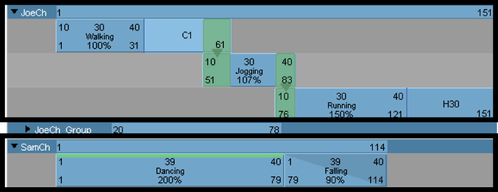
Character sets or characters are collections of animated objects, parts of objects, or attributes. If you create a clip for an animated object that is not already part of a character set, then the Trax Editor automatically creates a character for the clip. In the Trax Editor, characters appear as the first level of track hierarchy. This means that characters are the parents or top-level groups for all their tracks, groups, and subcharacters. See Track hierarchy.

Groups are arbitrary collections of clips for a single character. You can use groups to separate and isolate specific sequences of your character’s animation. See Group and ungroup clips. A character or subcharacter can have multiple groups, but you can not have groups within groups.

Subcharacter sets or subcharacters are bundles of related character set attributes. You can use subcharacters to simultaneously key and manipulate groups of attributes. See Create subcharacter sets in the Character Setup guide.
Subcharacters are on the same level of the track hierarchy as character groups. See Subcharacters. In the Trax Editor, subcharacters always appear below a character’s groups. Characters can have multiple subcharacters.
When working with subcharacters in the Trax Editor, note the following:
 Except where otherwise noted, this work is licensed under a Creative Commons Attribution-NonCommercial-ShareAlike 3.0 Unported License
Except where otherwise noted, this work is licensed under a Creative Commons Attribution-NonCommercial-ShareAlike 3.0 Unported License